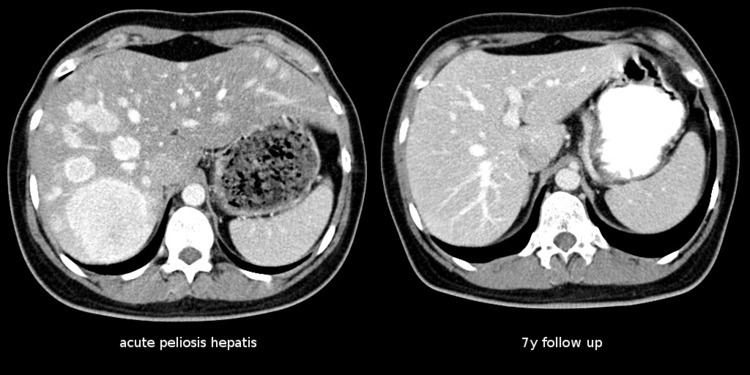Specialty Dentistry MeSH D010382 | ICD-10 K76.4 | |
 | ||
Peliosis hepatis is an uncommon vascular condition characterised by multiple randomly distributed blood-filled cavities throughout the liver. The size of the cavities usually ranges between a few millimetres to 3 cm in diameter. In the past it was a mere histological curiosity occasionally found at autopsies but has been increasingly recognised with wide ranging conditions from AIDS to the use of anabolic steroids. It also occasionally affects spleen, lymph nodes, lungs, kidneys, adrenal glands, bone marrow and other parts of gastrointestinal tract.
Contents
- Pathophysiology
- Disease associations
- Clinical features
- Treatment
- Other cystic conditions of liver
- References
Peliosis hepatis is often erroneously written "peliosis hepatitis", despite its not being one of the hepatitides. The correct term arises from the Greek pelios, i.e. discoloured by extravasated blood, livid, and the Latinized genitive case (hepatis) of the Greek hepar, liver.
Pathophysiology
The pathogenesis of peliosis hepatis is unknown. There are several hypotheses, such as, it arises from sinusoidal epithelial damage, increased sinusoidal pressure due to obstruction in blood outflow from the liver, or hepatocellular necrosis.
Two morphologic patterns of hepatic peliosis were described by Yanoff and Rawson. In the phlebectatic type, the blood-filled spaces are lined with endothelium and are associated with aneurysmal dilatation of the central vein; in the parenchymal type, the spaces have no endothelial lining and they usually are associated with haemorrhagic parenchymal necrosis. Some consider both patterns to be one process, initiated by focal necrosis of liver parenchyma, observed in parenchymal type, progressing into formation of fibrous wall and endothelial lining around haemorrhage of phlebectatic type. Fibrosis, cirrhosis, regenerative nodules, and tumours may also be seen.
Disease associations
Clinical features
The condition is typically asymptomatic and is discovered following evaluation of abnormal liver function test. However, when severe it can manifest as jaundice, hepatomegaly, liver failure and haemoperitoneum.
Treatment
Usually directed towards management of underlying cause. Withdrawal of azathioprine leads to remission in renal transplant, bacillary peliosis responds to antibiotics. In rare circumstances partial resection of liver or transplant may be required.
